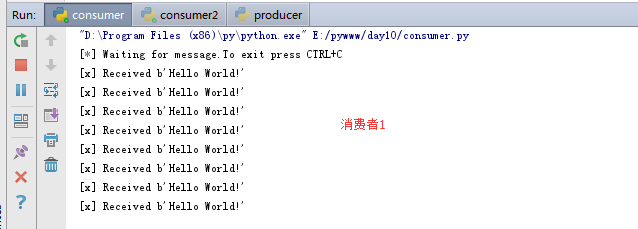python RabbitMQ广播
消息公平分发
如果Rabbit只管按顺序把消息发到各个消费者身上,不考虑消费者负载的话,很可能出现,一个机器配置不高的消费者那里堆积了很多消息处理不完,同时配置高的消费者却一直很轻松。为解决此问题,可以在各个消费者端,配置perfetch=1,意思就是告诉RabbitMQ在我这个消费者当前消息还没处理完的时候就不要再给我发新消息了。

消费者端添加
channel.basic_qos(prefetch_count=1)
带消息持久化+公平分发的完整代码
生产者
import pika
#相当于声明一个socket
conn = pika.BlockingConnection(pika.ConnectionParameters('localhost'))
#声明一个管道
channel = conn.channel()
#声明queue
channel.queue_declare(queue='hello',durable=True)
channel.basic_publish(exchange='',
routing_key='hello',
body='Hello World!',
properties=pika.BasicProperties(
delivery_mode=2,
)
) # routing_key 消息的key body 消息的内容
print('Sent "hello world"')
conn.close()
消费者
import pika
#相当于声明一个socket
conn = pika.BlockingConnection(pika.ConnectionParameters('localhost'))
#声明一个管道
channel = conn.channel()
#声明queue 这里可以不用声明,但是如果消费者先运行,又不希望出错,就要消费者先运行
channel.queue_declare(queue='hello',durable=True)
def callback(ch,method,properties,body):
print('[x] Received %r' % body )
ch.basic_ack(delivery_tag=method.delivery_tag)
channel.basic_qos(prefetch_count=1)
channel.basic_consume(callback, queue='hello' ) #消费消息 如果收到消息就调用CALLBACK函数处理
print('[*] Waiting for message.To exit press CTRL+C')
channel.start_consuming() #开始收消息
消费者2
import pika,time
#相当于声明一个socket
conn = pika.BlockingConnection(pika.ConnectionParameters('localhost'))
#声明一个管道
channel = conn.channel()
#声明queue 这里可以不用声明,但是如果消费者先运行,又不希望出错,就要消费者先运行
channel.queue_declare(queue='hello1',durable=True)
def callback(ch,method,properties,body):
time.sleep(30)
print('[x] Received %r' % body )
ch.basic_ack(delivery_tag=method.delivery_tag)
channel.basic_qos(prefetch_count=1)
channel.basic_consume(callback, queue='hello1' ) #消费消息 如果收到消息就调用CALLBACK函数处理
print('[*] Waiting for message.To exit press CTRL+C')
channel.start_consuming() #开始收消息
消费者2 CALLBACK中sleep30s 在这个过程中 将不会接收到消息,那么消息会发送到消费者1


Publish\Subscribe(消息发布\订阅)
之前的例子都基本都是1对1的消息发送和接收,即消息只能发送到指定的queue里,但有些时候你想让你的消息被所有的Queue收到,类似广播的效果,这时候就要用到exchange了,
exchange是一个简单的东西,一端接收消息,另一端将消息推送到队列。exchange类型将决定这条消息是放到一个队列,还是很多队列,还是被删除。exchange 就像转发器。
exchange的类型:
fanout: 所有bind到此exchange的queue都可以就收消息。 纯广播 ,只要绑定exchange就可以接收到。
direct: 通过routingKey和exchange决定的那个唯一的queue可以接收消息。
topic 所有符合routingkey(此时可以是一个表达式)的routingkey所bind的queue可以接收消息。
headers 通过headers 来决定把消息发给哪些queue。

消息publisher 生产者
import pika
import sys
connection = pika.BlockingConnection(pika.ConnectionParameters(
host='localhost'))
channel = connection.channel()
#发布方不需要声明queue 只需要有个exchange就可以了 , exchange_type 类型是 fanout
channel.exchange_declare(exchange='logs',exchange_type='fanout')
#message = ' '.join(sys.argv[1:]) or "info: Hello World!"
message = "info: Hello World!"
channel.basic_publish(exchange='logs', # 发布广播的时候 exchange定义要一致
routing_key='', #必须要写成空
body=message) #发送的消息主体
print(" [x] Sent %r" % message)
connection.close()
消费者
import pika
connection = pika.BlockingConnection(pika.ConnectionParameters(
host='localhost'))
channel = connection.channel()
channel.exchange_declare(exchange='logs', exchange_type='fanout') #exchange 转发器,exchange_type=fanout 绑定到这个转发器上的消费者都能接收到消息
result = channel.queue_declare(exclusive=True) # 随机queue 不指定queue名字,rabbit会随机分配一个名字,exclusive=True会在使用此queue的消费者断开后,自动将queue删除
queue_name = result.method.queue #获取queueu的名字
channel.queue_bind(exchange='logs', #绑定到这个转发器上,只能从这个转发器上接收
queue=queue_name) #指定queue的名字 转发器把消息发送到这个queue上,消费者从这个queue上接收消息
print(' [*] Waiting for logs. To exit press CTRL+C')
def callback(ch, method, properties, body):
print(" [x] %r" % body)
channel.basic_consume(callback,
queue=queue_name,
no_ack=True)
channel.start_consuming()
发送接收过程:
消费者要先在线,生产者发送消息,消费者才能接收到。
生产者

消费者1在线

消费者2在线

消费者3中断重新连接

广播并不会存下来,不在线就接收不到了。
有选择的接收消息(exchange type=direct)
RabbitMQ还支持根据关键字发送,即:队列绑定关键字,发送者将数据根据关键字发送到消息exchange,exchange根据 关键字 判定应该将数据发送至指定队列。

publisher
import pika
import sys
connection = pika.BlockingConnection(pika.ConnectionParameters(
host='localhost'))
channel = connection.channel()
channel.exchange_declare(exchange='direct_logs',
type='direct')
severity = sys.argv[1] if len(sys.argv) > 1 else 'info'
message = ' '.join(sys.argv[2:]) or 'Hello World!'
channel.basic_publish(exchange='direct_logs',
routing_key=severity,
body=message)
print(" [x] Sent %r:%r" % (severity, message))
connection.close()
subscriber
import pika
import sys
connection = pika.BlockingConnection(pika.ConnectionParameters(
host='localhost'))
channel = connection.channel()
channel.exchange_declare(exchange='direct_logs',
type='direct')
result = channel.queue_declare(exclusive=True)
queue_name = result.method.queue
severities = sys.argv[1:]
if not severities:
sys.stderr.write("Usage: %s [info] [warning] [error]\n" % sys.argv[0])
sys.exit(1)
for severity in severities:
channel.queue_bind(exchange='direct_logs',
queue=queue_name,
routing_key=severity)
print(' [*] Waiting for logs. To exit press CTRL+C')
def callback(ch, method, properties, body):
print(" [x] %r:%r" % (method.routing_key, body))
channel.basic_consume(callback,
queue=queue_name,
no_ack=True)
channel.start_consuming()
服务器端

消费者端

绑定哪个就能接收的哪个的消息。
更细致的消息过滤(exchange type=topic)
上面的过滤条件是写死的,更细致的过滤条件就是在上面的基础上,对过滤参数的匹配。类似与正则匹配。

publisher
import pika
import sys
connection = pika.BlockingConnection(pika.ConnectionParameters(
host='localhost'))
channel = connection.channel()
channel.exchange_declare(exchange='topic_logs',
type='topic')
routing_key = sys.argv[1] if len(sys.argv) > 1 else 'anonymous.info'
message = ' '.join(sys.argv[2:]) or 'Hello World!'
channel.basic_publish(exchange='topic_logs',
routing_key=routing_key,
body=message)
print(" [x] Sent %r:%r" % (routing_key, message))
connection.close()
subscriber
import pika
import sys
connection = pika.BlockingConnection(pika.ConnectionParameters(
host='localhost'))
channel = connection.channel()
channel.exchange_declare(exchange='topic_logs',
type='topic')
result = channel.queue_declare(exclusive=True)
queue_name = result.method.queue
binding_keys = sys.argv[1:]
if not binding_keys:
sys.stderr.write("Usage: %s [binding_key]...\n" % sys.argv[0])
sys.exit(1)
for binding_key in binding_keys:
channel.queue_bind(exchange='topic_logs',
queue=queue_name,
routing_key=binding_key)
print(' [*] Waiting for logs. To exit press CTRL+C')
def callback(ch, method, properties, body):
print(" [x] %r:%r" % (method.routing_key, body))
channel.basic_consume(callback,
queue=queue_name,
no_ack=True)
channel.start_consuming()





 浙公网安备 33010602011771号
浙公网安备 33010602011771号